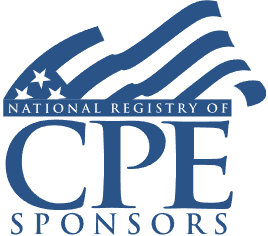PALs and NOLs in Trusts and Estates: Strategies to Maximize Utilization
Calculating Basis in Inherited Assets and Gifts Transferred With PAL Carryovers, Determining Material and Active Participation

Course Details
- smart_display Format
On-Demand
- signal_cellular_alt Difficulty Level
Intermediate
- work Practice Area
Tax Preparer
- event Date
Wednesday, January 29, 2025
- schedule Time
1:00 p.m. ET./10:00 a.m. PT
- timer Program Length
110 minutes
-
BARBRI is a NASBA CPE sponsor and this 110-minute webinar is accredited for 2.0 CPE credits.
-
BARBRI is an IRS-approved continuing education provider offering certified courses for Enrolled Agents (EA) and Tax Return Preparers (RTRP).
This webinar will review the rules for deducting passive activity losses (PALs) and net operating losses (NOLs) by decedents, trusts, and estates. The panel will point out key considerations when gifting assets with PALs or NOLs, demonstrate the participation rules as they apply to trusts and estates, and point out ways to preserve the deductibility of these losses upon transfer or death.
Faculty

Ms. Fukuto is a Tax Partner and specializes in the Estate and Trust Tax Services for Eide Bailly, LLP, a certified public accounting firm. With over 40 years of experience, she provides tax compliance, planning and consulting services for high net worth individuals, business succession and perpetuation planning for closely-held businesses and non-profit organizations. Ms. Fukuto's expertise includes estate and trust plan review and development, implementation and administration, tax compliance and strategic consulting services that allow her to work with complex estates and family wealth transfer issues. She obtained her Bachelor of Science in Accounting from the University of Southern California and her Masters degree in Taxation from Golden Gate University. Ms. Fukuto is a member of the American Institute of Certified Public Accountants and the California Society of Certified Public Accountants. She is also the Former Chair for the Orange County Estate Planning Council and Former Chair of the State Estate Planning Interest Group for the California Society of Certified Public Accountants.

Ms. Rentschler is experienced in tax compliance of pass-through entities, trusts and estates, and high net worth individuals. She provides consulting services on business structure, accounting and general tax planning, and she assists individuals with estate and trust planning and administration matters.
Description
The requirements for deducting PALs under IRC Section 469 are complex. The considerations and calculations increase significantly when a trust or estate holds these losses. A decedent might be entitled to deduct a PAL on the final return but only after adjusting for the basis step-up. A trust's or estate's distribution of a passive interest can trigger a basis step-up for passive loss carryforwards.
Like interests held by members or shareholders, the material and active participation rules come into play when considering deductions of PALs by a trust or estate. The level of participation must be reconsidered anytime an interest is transferred. There are no statutory rules for determining the level of participation in an activity of a trust or estate. Advisers working with pass-through entities and individuals holding potentially passive investments must understand the deductibility of PALs and NOLs by trusts and estates.
Listen as our panel explains planning to maximize the use of NOLs and PALs held by or potentially held by a trust or estate.
Outline
- Utilizing PALs and NOLs in trusts and estates
- PALs
- Decedent's
- Gifting assets with PALs
- Distributions of pass-through entity interests
- Other considerations
- NOLs
- Examples
- Best practices
Benefits
The panel will cover these and other critical issues:
- Strategies to maximize utilization of PALs and NOLs in trusts and estates
- Calculating basis in gifts transferred with passive activity carryovers
- Determining material and active participation for activities held by a trust or estate
- When NOLs are and are not deductible by a beneficiary
- Filing requirements for trusts with passive activities
NASBA Details
Learning Objectives
After completing this course, you will be able to:
- Identify key considerations when transferring partnership interests with PALs
- Determine basis in assets gifted with PAL carryovers
- Decide when, how, and if NOLs in trusts are distributed to beneficiaries
- Ascertain how the basis in inherited assets with suspended PALs is calculated
- Field of Study: Taxes
- Level of Knowledge: Intermediate
- Advance Preparation: None
- Teaching Method: Seminar/Lecture
- Delivery Method: Group-Internet (via computer)
- Attendance Monitoring Method: Attendance is monitored electronically via a participant's PIN and through a series of attendance verification prompts displayed throughout the program
- Prerequisite: Three years+ business or public firm experience preparing complex tax forms and schedules, supervising other preparers or accountants. Specific knowledge and understanding of estate, gift and trust taxation including various trusts types, the unified credit, and portability.

Strafford Publications, Inc. is registered with the National Association of State Boards of Accountancy (NASBA) as a sponsor of continuing professional education on the National Registry of CPE Sponsors. State boards of Accountancy have final authority on the acceptance of individual courses for CPE Credits. Complaints regarding registered sponsons may be submitted to NASBA through its website: www.nasbaregistry.org.

Strafford is an IRS-approved continuing education provider offering certified courses for Enrolled Agents (EA) and Tax Return Preparers (RTRP).
Related Courses

Medicaid Asset Protection Trusts: Technical Overview and Tax Considerations
Available On-Demand

Family Partnerships: Navigating the Discounting Rules for Family-Controlled Entities
Thursday, March 6, 2025
1:00 p.m. ET./10:00 a.m. PT

Form 1041 Schedule D: Reporting Capital Gains for Trusts and Estates
Available On-Demand
Recommended Resources
How CPE Can Bridge the Gap Between What You Know and What You Need to Know
- Career Advancement